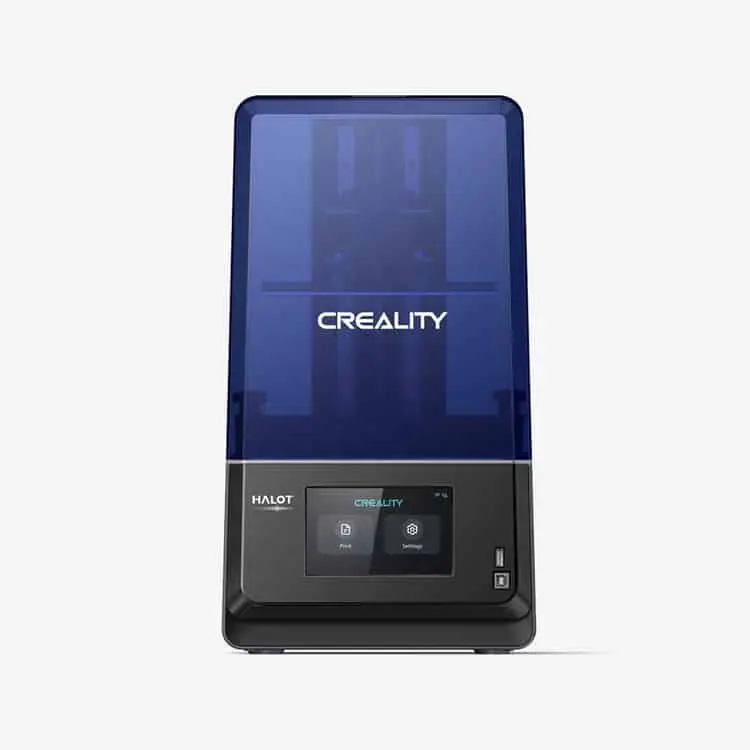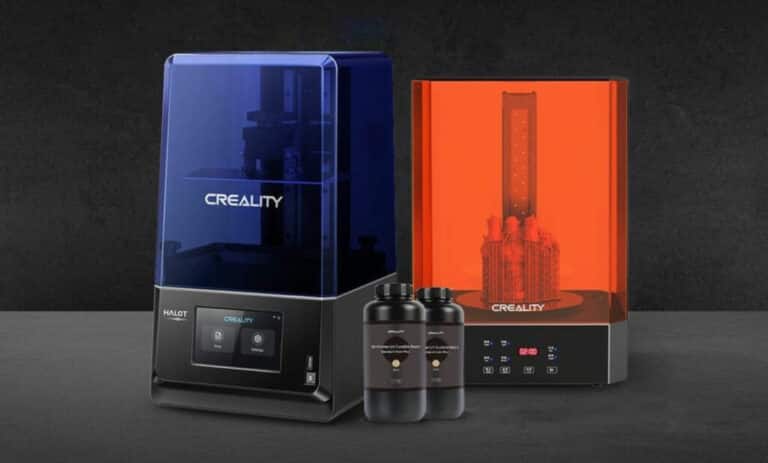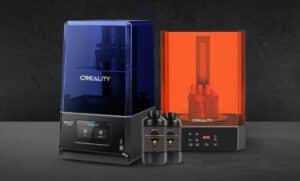The Creality Halot One Plus is the first attempt at resin printing, despite the fact that I developed a bit of a 3D printing addiction over the previous few years.
For those who are new to 3D printing or merely resin printers, it’s crucial to understand that resin printers & FDM printers (the kind that prints using a spool of filament), such as the Creality Sermon V1 Pro, have significant distinctions.
This is not the place to compare the two technologies, and it is important to be aware that a “wash and cure†station is also required for resin printers like the Halot One Plus. Unlike an FDM printer, the Creality Halot One Plus requires additional steps after printing is complete. First, the uncured resin must be removed from the print (together with any supports); it must be UV-cured.
As in Halot One range, which also contains the Pro and Halot One, the Halot One Plus is the most expensive model. It boasts the greatest build volume, the largest LCD, and the highest resolution of the three.
Its higher cost is not surprising, but the real question is if it’s worthwhile to purchase.
What will you see here?
Packaging and Shipping
The Creality Halot One Plus ships in a cardboard box with plenty of foam protection on all sides. Similar to the majority of resin printers. The unboxing process was a little bit simpler this time because they remembered to start at the bottom of the box.
There is little risk that the printer arrives damaged because it is neatly packaged.
It discovers an extra FEP sheet in addition to the usual filters, spatula, & USB drive. One of the most helpful items you can receive in the package is a spare FEP sheet because it’s consumable and could be more difficult to locate if a new printer is introduced to the market.
Features & design

The Creality Halot One Plus is rather small and totally enclosed when compared to an FDM printer. Its dimensions are 236x243x418mm, and its weight is just under 7kg. The cover is necessary to shield your eyes from UV rays, and because of its dark blue color, it is difficult to look through.
Thanks to the huge displays, you can see how much time is left in the print job or how many layers include already printed (out of the total). Like a phone, it has a capacitive touchscreen, which makes it simple to explore menus, alter settings, select prints to make, and input your Wi-Fi password.
Two USB ports are located next to the screen, one for a flash drive carrying print files and the other for a type-B port for connecting directly to a PC.
Wi-Fi
You won’t likely need a connected connection because of the built-in Wi-Fi. You can even access Creality’s Cloud service to download prints directly to the printer. These models can then print and sliced using the Halot One Plus.
It might prefer to source your models from somewhere else if you want to prevent unintentionally printing anything you should pay for because we heard a lot of people say that some of the models provided are “stolen” and violate copyright.
A metal resin plate with a clear FEP sheet screwed to the bottom is located underneath the lid. A spare is provided in the box, which would be helpful.
In order to prevent the loss, the tray contains marks for 250, 450, and 650 ml in addition to captive screws. Lips on 2 different corners make it simpler to pour leftover resin back into the bottle.
Creality Halot One Plus has Four Allen bolts
Four Allen bolts on the aluminum construction plate must be released before leveling. The calibration sheet must be placed on top of the LCD screen. When the build plate has been dropped on top of the sheet, the bolts must be tightened. This is a straightforward procedure (in comparison to an FDM printer).
Although the build plate’s top is inclined to aid resin runoff, a steeper pitch is actually needed since some resin is left over after printing & gets caught all around bolts.
The 7.9in LCD’s 43202560 resolution is higher than that of many resin printers. Similar to graphics, prints with higher resolution appear smoother, while prints with lesser resolution appear blockier. These are some of the causes the Halot One Plus is more expensive than resin printers with lower resolution is because of this.
UV LED
However, as the UV light must be evenly distributed across the screen in order to generate resin 3D prints, this is crucial. Many resin printers use UV LED matrices. But Creality has created its own “integral light source†that, according to the company. It can achieve over 90% “evenness,†as opposed to about 50% for resin prints made with “parallel emission.â€
Additionally, it is said that there are fewer issues with broken units inside the matrix because it employs a lot fewer LEDs than a matrix.
The Creality Halot One Plus seems to have an XY axis precision of 0.04mm and can print in 0.01mm layer heights. Due to the two rails on the Z-axis, tall prints should not deviate from the intended path.
Camera Monitor settings
It’s a good thing that firmware updates can be performed wirelessly over the air, and Creality claims that one’s team is working on supporting webcams. The fact that the menus already include references to cameras confused me, but the “Camera password” as in Camera Monitor settings is really the password (token) you must provide if you wish to print from a PC via Wi-Fi.
It would be beneficial to have webcam support if the cover wasn’t so dark that it was impossible to see what was being printed because that would need mounting the camera outside of the cover.
The Creality Halot One Plus resin printer has two fans, one for the UV LED and another for the activated charcoal filter. The fans run continuously during printing, making the device rather loud. The scent wasn’t too bad while using Creality’s own resin, but it was clear that the filter hadn’t been able to entirely eliminate it.
Only a plastic scraper, one paper filter (used to drain resin down the bottle), or a few Allen keys are provided in the box of accessories. The only other items you’ll need to purchase are some IPA (isopropyl alcohol) for clean prints and some flush cutters for deleting supports, as neither gloves nor flush cutters are there.
The $219/£179 Creality UW-02 washing & curing machine can also be something you wish to get.
Specs

- 172 x 102 x 160 mm for the print volume.
- Resolution XY is 4320 by 2560. (4K).
- Pixel size and XY accuracy: 0.04 mm (40 m).
- Layer thickness and Z-accuracy: 0.01-0.2 mm.
- 1-4 seconds per layer for printing (depending on the resin used).
- The wavelength of UV light: is 405 nm.
- Layer thickness and Z-accuracy: 0.01-0.2 mm.
- 4.9-inch color touchscreen for touch devices.
- Energy: 100W.
- Energy source: 100-240 V, 50/60 Hz.
- Dimensions: 236 by 243 by 418 mm.
- Size: 6.9 kilograms.
Slicers
There are various slicers available. The Halot Box, Lychee Slicer, and ChiTuBox are all proprietary to Creality. They chose Halot Box because you hadn’t used all these before.
Although you will have to know how to add support to resin models, it is rather simple. The time it takes to manually install supports where you want them is time well spent because the auto-generated supports weren’t placed in the most logical locations.
After establishing and entering the password, you can print directly to the Creality Halot One Plus resin printer via Wi-Fi or export the sliced model to a USB drive. The program will estimate the print time and amount of resin needed.
Printing

It has used default print parameters and a Minion model that you acquired from Creality Cloud for the initial print. Surprisingly, it printed flawlessly and without any issues at all—exactly the reverse of every FDM printer I’ve tested.
Since you didn’t get a wash-and-cure machine on hand, So used a bath of IPA to rinse the uncured resin but then left it outside in the sun for a good several hours. The model stood from the build plate using a plastic scraper.
Its white resin took on almost a peach hue once it had dried, as resin prints do change color when they cure.
13 hours to print
They chose something considerably more challenging for the second test. A replica of Captain Jack Sparrow that took up a sizable amount of the maximum height. Although it took slightly more than 13 hours to print, it did it successfully the first time.
The beard, jacket, hardwood floor, and rope all had excellent texture, and there was amazing attention to detail.
Before they are fully cured, resin prints are somewhat pliable. But it can then become brittle, so you have to be careful not to snap off portions like the sword. When eliminating support from this model, one of its two chin braids broke off.
The primary issue with this print was how quickly it adhered to the build plate and how challenging it was to remove. Even with a metal scraper, it was difficult to pry it off. So would have to resort to this. However, this was mostly resolved for subsequent prints by shortening the first-layer curing time.
Challenge Tower of Pi was yet another test. Due to the near impossibility of accomplishing on an FDM printer, the designers produced a variant with walls. However, the Halot One Plus handled it with ease, printing 150 mm tall and 85 mm wide at nearly 100% accuracy.
Creality Halot One Plus: 0.04mm XY resolution
Sole a few filled-in holes in a couple of the number 8s were the only flaws. Although it wasn’t there all the way around, some parts seemed absolutely smooth. You can also see stepping all around the edge (on the left side of the image above). So it’s not only the 0.04mm XY resolution at work.
Importantly, the Z-axis precision was flawless, and the prints featuring vertical surfaces were likewise nicely smooth.
The overall print quality is good because of the excellent light homogeneity. You can utilize the entire build plate without compromising print quality.
A “cleaning” cycle that cures an entire layer can conduct after printing to remove any small particles that may have fallen into the resin vat.
They ran it twice more because the default time of 25 seconds wasn’t long enough. To allow the cured resin to remove using a plastic scraper.
Is it worth buying the Creality Halot One Plus?

Comparatively speaking, the Anycubic Photon M3 costs $100 less. It differs from the Halot in a few ways, including its smaller touchscreen, single linear Z rail, and lack of an inbuilt light source.
The availability is less widespread in the UK than it is in the US. It was the only UK retailer offering it for sale, and it cost £469 there. You cannot purchase one through Creality’s website.
The Photon M3 is £174 cheaper and costs £295, letting the Creality Halot One Plus resin printer appear to be expensive. Since it’s brand-new. Hopefully, pricing will drop until there is a better supply (& Creality plans to start selling directly to UK customers in the near future).
Resin bottles cost a lot of money. Since they sell by weight, a 1kg bottle will run you $35–$40. Creality offers both normal resin and water-washable resin in a range of colors.
Conclusion
Overall, the Creality Halot One Plus is an excellent resin printer. It generates high-quality prints quickly and consistently.
Unless you go to an FDM printer, there seems to be no way to prevent this. After printing, messy support removing, cleaning, and curing operations are necessary for all resin printers.
The Creality Halot One Plus’s primary flaw, aside from being a little noisier than they prefer, is its price. Many first-time customers will find it challenging to justify the additional cost because it is substantially more expensive than the Photon M3.
Suppose you’re not a beginner and care about having the finest print quality. You could able to justify investing more if you really want the additional light uniformity of a Halot One Plus’ inherent light source.
















